Into the Quantum with H. Beam Piper
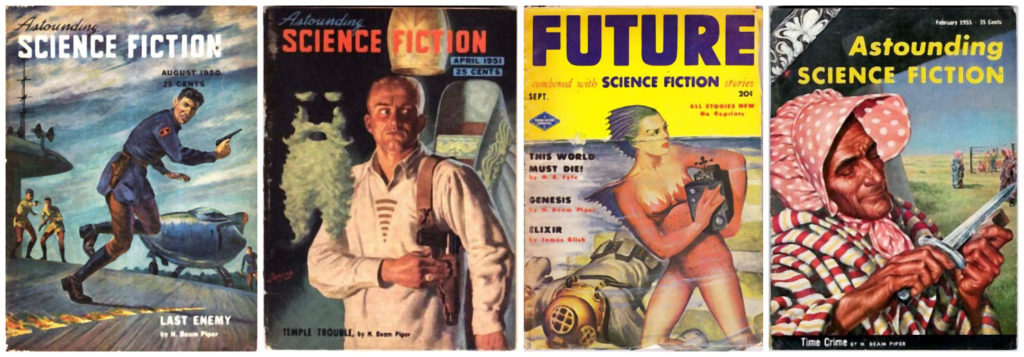
H. Beam Piper wrote a great deal about Time. His books and stories seem split into two types: travel via mechanical means, such as in the Paratime Police stories, and consciousness travel, such as in “The Edge of a Knife.” This article will look at both.
Piper wasn’t the first to write science fiction about parallel realities. Murray Leinster was the groundbreaker for that in “Sideways in Time” (1934). In 1947, Fredric Brown brought us his delightful parallel reality story, What Mad Universe. That same year, H. Beam Piper published his first time travel story, “Time and Again.” This was not a tale about purposeful travel but accidental, through a hellacious explosion. And it wasn’t about physical time travel at all, but consciousness travel. We’ll return to this type of time travel later in the article.
Paratime
Verkan Vall is the hero of most of the Paratime police stories. His official title is Special Chief’s Assistant to the chief of the Paratime Police — Tortha Karf. Through his adventures we learn about the Home timeline of the First Probability Level and get a look at the complex spider web of realities that the Paratime Police oversee.
Before diving into the various Paratime stories it’s useful to take a deeper look into their world. The majority of the characters are Earthly humans, although some have been born on Venus (Mars, too, probably.) They live in a world where reality is acknowledged not to be singular, but infinite. If you can imagine it, it probably exists on some timeline, somewhere. The hero’s First Level people have not explored every timeline as that would be impossible. But they have made contact with quite a few and have casual knowledge of many more. They are self-acknowledged time pirates (or parasites) who profit off the goods, services, and labor of other timelines. Their most heavily-guarded secret is the Ghaldron-Hesthor field generator. This is the ultimate reference point for the First Level probability timeline — they developed the device and other timelines didn’t. The field generator must remain a carefully guarded secret and it’s the job of the Paratime Police make sure it stays that way. Their population is hypnotically conditioned to never expose the secret.
To quote Verkan Vall:
The Ghaldron-Hesthor field generator is a device which can transpose to any other timeline, and carry with it anything inside its field, but it can’t go outside its own temporal area of existence, any more than a bullet from that rifle can hit the target a week before it’s fired.
So, it can travel across timelines but not backwards or forwards in time.
The Complete Paratime (Ace Books, 2001). Cover by Dave Dorman
Piper’s First Level society talks about travel in terms of parallels, or parayears. Timelines are grouped, firstly, into Probability Levels. I conceive of these as major timeline highways. Cutting it finer are alternate timelines similar to, but not necessarily TOO similar to, the main level timeline. For instance, it’s admitted that our main timeline is the Fourth Probability Level. This is a barbarous level which started late and progressed slowly. It is suggested that we will attempt to destroy ourselves by foolish technological or biological choices on at least some of these parallels. The clustered timelines making up this level are endless variations on the theme. To use a simple example, in our timeline the Allies won WWII. In others, they did not.
The First Level society is technologically advanced because it is ancient, not because they live in the future. Their culture is approximately 75,000 years old, which refers to the date when Mars successfully colonized Earth. Here is what Verkan Vall has to say about that:
There are five main probability levels, derived from the five possible outcomes of the attempt to colonize this planet, seventy-five thousand years ago. We are on the First Level — complete success, and colony fully established. The Fifth Level is the probability of complete failure — no human population established on this planet, and indigenous quasi-human life evolved indigenously. On the Fourth Level, the colonists evidently met with some disaster and lost all memory of their extraterrestrial origin, as well as all extraterrestrial culture. As far as they know, they are an indigenous race; they have a long pre-history of stone-age savagery.
So, all of Vall’s adventures are contemporaneous to us now. They are simply on a “more successful” human timeline.
Police Operation & He Walked Around the Horses
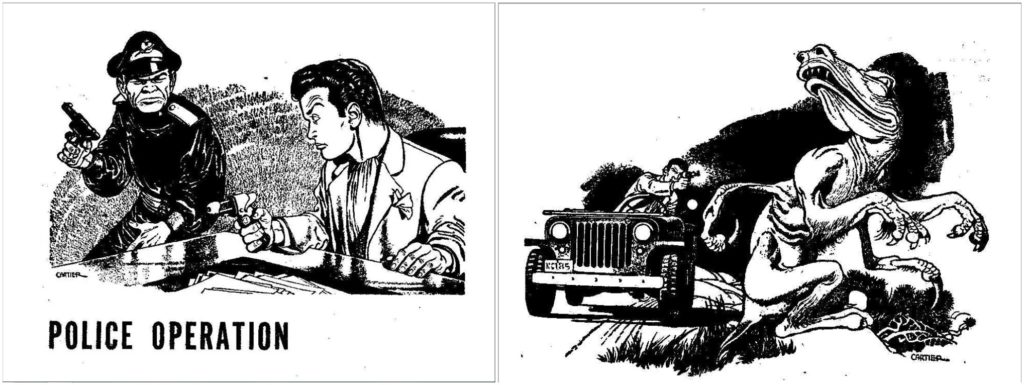
Verkan Vall’s first adventure is in “Police Operation” (1948). He travels to the Fourth Level to capture a rogue Venusian nighthound. The beast escaped after its First Level owner died in a freak car crash. The paracops can’t let it be found as it is absolutely of extraterrestrial origin and if it is later recognized as Venusian (which could happen if our timeline survives long enough to colonize Venus) someone will figure out what it is. So, the police operation of the title is a clean-up procedure. The story is a wonderful introduction to the world of the Paratime Police and how they operate.
According to Piper himself, this is the first Paratime story. However, there is another “timeslip” story that is sometimes added to the Paratime list. “He Walked Around the Horses” (1948) came out a few months before “Police Operation.” It’s based on a real incident of a British diplomat walking around a corner and never being seen or heard from again. Benjamin Bathurst disappeared on or about November 25, 1809. Piper got his paratime feet wet with his version of what happened to the lost diplomat. There is no mention of Verkan Vall’s people in this tale. However, it is my opinion that the incidence of Bathhurst’s vanishing is explained by Paratime Police chief, Tortha Karf, in “Police Operation.” It is shown that it is possible to pick up unwanted passengers on trips across parallels. Karf explains that when he was a young paracop, 139 years before, he accidentally picked up a man on the Fourth Level and dragged him across a couple of hundred parayears (that’s quite a ways sideways). He later went back to find the man but he’d been shot trying to escape. “Police Operation” came out in 1948. One hundred and fifty years before that is 1809, the year Bathurst vanished!
Last Enemy
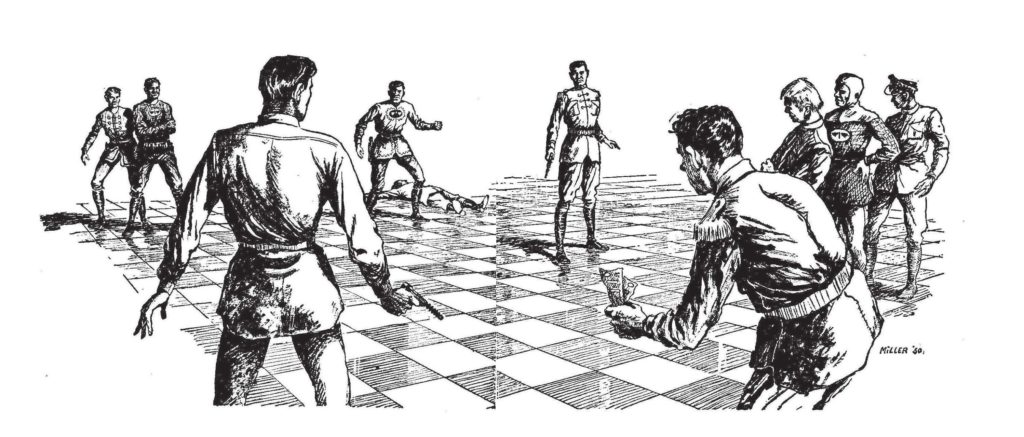
I find “Last Enemy” (1950) the most captivating of all of the Paratime stories. It takes place mainly on the Second Level, an advanced civilization but without the knowledge of the all-important Ghaldron-Hesthor field generator and the secret of paratemporal transposition. In this story, we see Piper contemplate a world (timeline) where reincarnation of souls is an accepted fact. People are aware that they are eternal souls living in a series of bodies. The political structure is based on whether or not you can consciously decide on your next reincarnation vessel. People aren’t afraid of death as they know they will live again at some point.
In this story, Verkan Vall is on a rescue mission. A First Level scientist on assignment is missing and he must find her. The woman’s name is Hadron Dalla and she happens to be his ex-wife. Dalla’s been working on this sector for a year under cover. Her specialty is psychic research and, unintentionally, she raises the level of reincarnation research and runs afoul of one of the political groups. Vall must go to her rescue not because of emotional attachment, but because the secret of temporal transposition is at risk. If she dies on that sector of the Second Level, she will reincarnate there. Then, under trance recall (hypnosis), she’d reveal what she knew about her previous life on the First Level and the paratime secret. He must stop this from happening at all costs.
Temple Trouble
“Temple Trouble” (1951) is a straight-forward adventure. On the Fourth Level (but a very different reality from our own), the First Level Transtemporal Mining Company is excavating fissionable ores. They work under the cover of a series of temples to the god, Yat-Zar. They have an elaborate set-up to preserve the illusion that they are a real religious sect. But, even established operations can run afoul of ill-luck and this one has in the form of a local prince, the priests of an ambitious alligator god, and some bad judgement calls from Management. In order to preserve the temporal transposition secret, Verkan Vall and his paratime police must set things right in the House of Yat-Zar without delay. The climax is certainly fun but I would rank this as the weakest of the Paratime stories.
Genesis
“Genesis” (1951) was not listed by Piper as one of the Paratime stories and yet it is, as it forms the basis for at least some of the probability levels. I believe this is how the Third, and maybe the Fourth, Probability Levels started — with an abortive attempt to colonize Earth from Mars about one hundred thousand years ago. After a spaceship wreck, only a few of the colonists survive. They struggle to stay alive while competing with fierce, semi-human primitives. Gradually, their technology fails and they must make due with crude equivalents. As we watch, their descendants regress into ignorant savagery. It’s an engaging story but also a heart-breaker. You can’t help but cheer for the heroic group of survivors, knowing that they and all their descendants will fall far before mankind can rise again into civilized life.
Time Crime
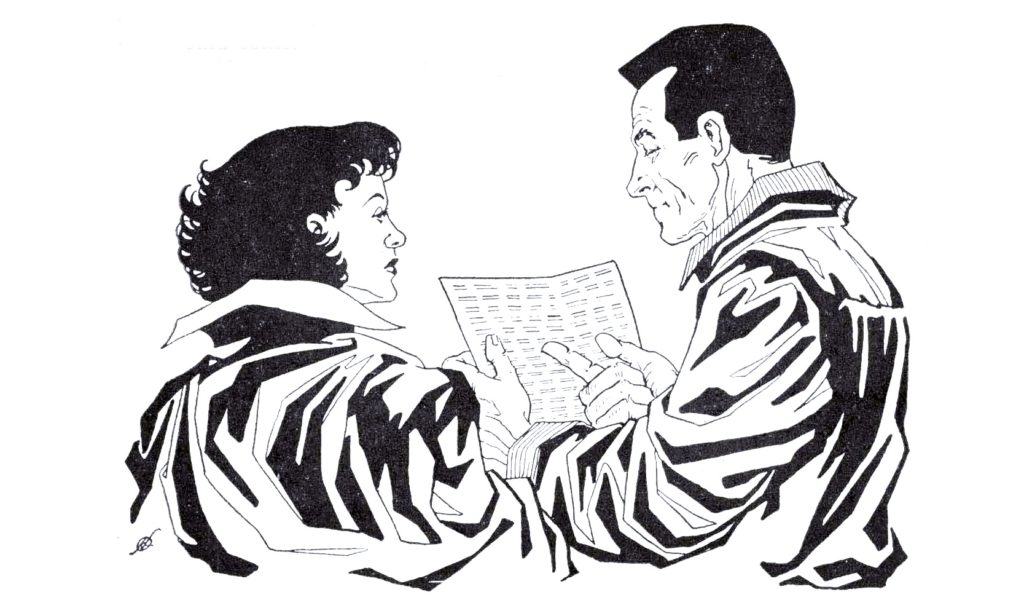
“Time Crime” (1955) is the longest of the Paratime tales (with the exception of the Lord Kalvan stories) and it gives the most in-depth view of the First Level civilization. It was initially published in two parts in Astounding in February and March of 1955. I am certain that many people today would take issue with the interplay between the characters in this story as it is pure 1955. I will not comment on this further except to say that it serves as a time capsule and should be taken as an artifact of that time.
After the events of “Last Enemy,” Verkan Vall and Hadron Dalla have re-married. They make an excellent power couple and that is seen in action in this story. They’re about to go on vacation when Tortha Karf intervenes. There’s trouble and will Vall and Dalla stop by his office before taking their rocket? They’re told that a slave trading operation has been discovered on the Third Level and is running across parallels. When Vall and Dalla investigate they discover a deep covert operation reaching all the way to the top of the political structure of the Home timeline. The infiltration is so deep that Tortha Karf is implicated and an attempt is made to dislodge him as Paratime Police Chief. But the bigger problem is where is the slaver’s base? It could literally be anywhere amongst a multitude of timelines associated with a variety of levels. When they finally discover the location through clever detective work, they’re shocked. It’s right… no! I’m not going to tell you. Suffice to say that it’s the last place they’d think to look. When the dust settles, Tortha Karf asks Vall to take over as the head of an important task force charged with routing out the rest of the Paratemportal Crime-Ring.
The Paratime stories are not fully complete without “Gunpowder God” and “Down Styphon!”, published together as Lord Kalvan of Otherwhen. This will be a topic of a future article.
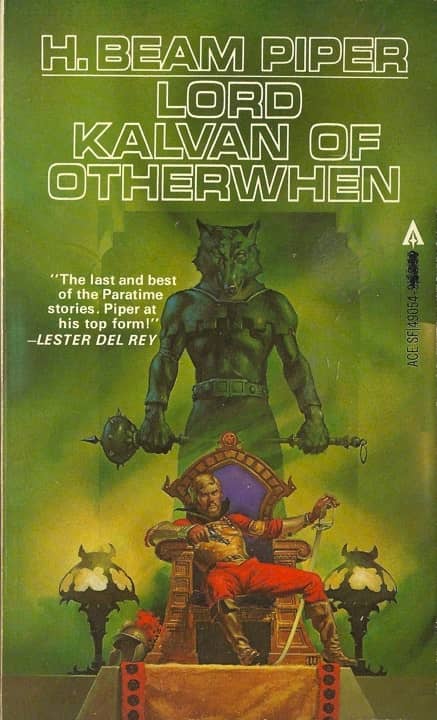 |
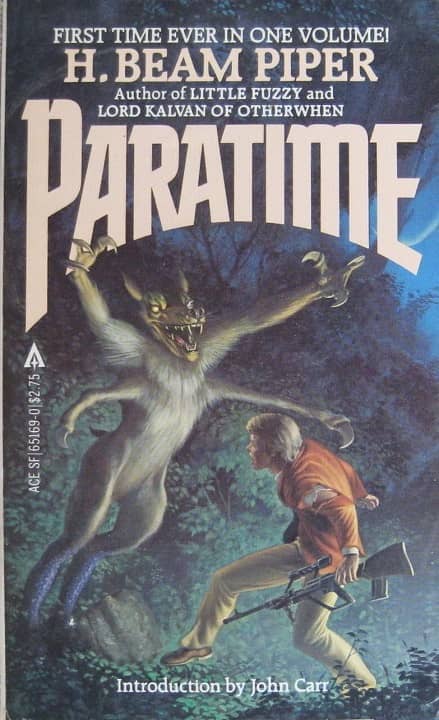 |
Lord Kalvan of Otherwhen (Ace, 1977) and Paratime (Ace Books, 1981). Covers by Michael Whelan
Consciousness Travel
The Paratime stories are not about the future, they’re about the present on parallel realities. But Piper has two stories that are about time travel — “Time and Again” and “The Edge of the Knife.” Perhaps it’s more fair to say that the latter is about multidimensional travel and non-linear time. However, in both cases, time travel is based on consciousness travel and not by mechanical means.
In “Time and Again” (1947) Allan Hartley is dying on the battlefield in the future. He appears to have an Near Death Experience and recalls his childhood. Then… he wakes up in his 13-year-old body! He’s just lost 30 years, all of which he remembers. He keeps the truth to himself until an incident with a neighbor, one that he’s forgotten, gives him the chance to prove the truth of his claims to his father. Fortunately, his father is convinced and there follows an interesting conversation about the nature of time and consciousness. It becomes clear that Allan’s actions have already changed that timeline. Can other things also be changed? They launch a scheme to prevent WWIII and this is where the story ends.
“The Edge of the Knife” was published ten years later, in 1957. It’s considered part of the Terro-Human Empire series. Ed Chalmers is a college history professor with an odd problem — he “remembers” future events. He doesn’t know how this occurs, or why. All he knows is that the information bubbles up from his subconscious and that it’s real. He lives on “the edge of a knife” as he tries to keep the present distinct from the past and future. To make his task harder, he knows that there’s a devastating war coming and no one believes him. In basic outline, the story’s plot is far from unique — a hero with foreknowledge tries to warn people of an upcoming disaster. What makes the story unusual is that Chalmers is living in an ever-present “now” — past, present, and future are equally real to him. In the end, he solves his problems by making a few clever, and difficult, 3-D chess moves.
Quantum Tales
H. Beam Piper’s Paratime universe has a particularly clear and cogent structure. I can think of no other science fiction writer of the same era who’s created an equally solid explanation for such a complex idea. I find it interesting that Jack Finney published “The Third Level” the same year as “The Edge of the Knife.” It was Finney’s first time travel story while “The Edge of the Knife” was one of Piper’s last. Perhaps it’s a romantic notion but I can’t help but think a torch was being passed.
“Time and Again” and “The Edge of the Knife” are very different explorations of time and consciousness. How fluid is time, really? Is it just a construct of our minds? I once read that time travel is accomplished with the mind first and then the body. Piper seems to have been toying with the same idea. I must wonder — was it really Time that interested him? Or, was it the universality of consciousness within the scope of time? We will never know the answer to that. We can, instead, enjoy his exciting stories and wonder, as I’m sure he meant us to.
SARA LIGHT-WALLER is a writer, illustrator, and avid pulp fan. In 2020, she won the prestigious Cosmos Award for her illustrated space opera story — “Battle at Neptune.” She’s published two illustrated new pulp books: Landscape of Darkness and Anchor: A Strange Tale of Time, and is a regular contributor to several pulp blogs. Catch up with her at Lucina Press.
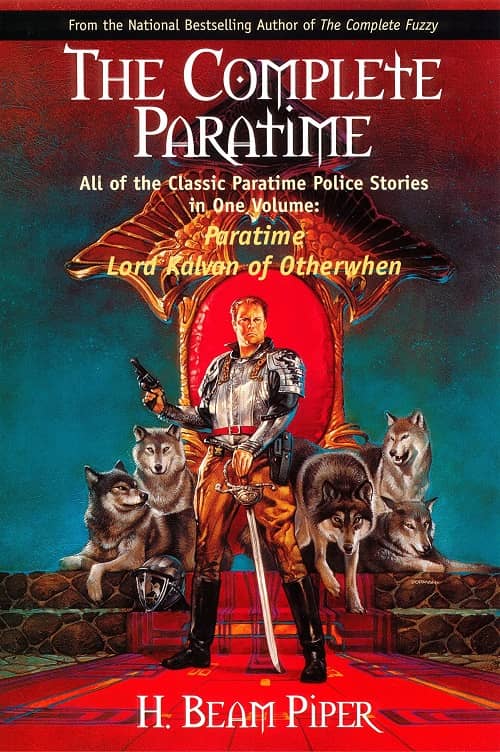
[…] to ANCHOR, is right in this line. But more about that on another time. For today, let’s delve Into the Quantum with H. Beam Piper over at Black […]
I first ran across the Paratime stories of H. Beam Piper 50 years ago and they had an immense impact on my reading (military history) and my decision to start writing. Your article reminds me of that time.
Excellent post. Thank you, Miss Light-Waller.
Thank you, John. That’s very kind. Piper obviously was a military enthusiast and I can imagine that he would inspire anyone to be interested in that, or anything. 🙂 I have a background in historical archaeology myself and all of his talk of guns (especially in the Lord Kalvan stories) remind me of lectures on the differences between matchlocks, flintlocks, and wheelocks. I would have loved to interview him in person, ah well!
Thanks for introducing me to another pulp science fiction writer. I’m anxious to begin making my way through these stories.